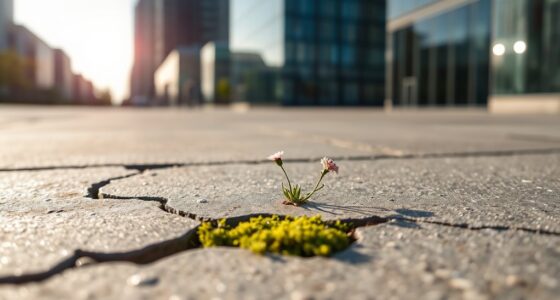Lab-grown wood can truly help save forests by offering a sustainable alternative to traditional timber. It reduces the need for large-scale logging, conserving natural habitats and protecting biodiversity. Cultivated in controlled environments, lab-grown wood uses less water, land, and energy, producing a lower carbon footprint. While some still question its strength and appearance, ongoing innovations are making it more comparable to natural wood. Keep exploring to discover how this technology could reshape our environmental future.
Key Takeaways
- Lab-grown wood reduces the need for deforestation by providing a sustainable alternative to natural timber.
- It minimizes environmental impacts like soil erosion, chemical pollution, and habitat destruction associated with traditional logging.
- Advances in technology enhance the quality and strength of lab-grown wood, making it suitable for various applications.
- Cultivated wood helps conserve biodiversity and protect natural ecosystems for future generations.
- It offers a scalable solution to meet market demand while decreasing pressure on natural forests.

Have you ever wondered if lab-grown wood could help ease the pressure on our forests? It’s a question gaining traction as scientists explore sustainable alternatives to traditional wood harvesting. Lab-grown wood, also called cultivated or synthetic wood, is produced through innovative biotechnologies that mimic natural tree growth in controlled environments. The idea is to provide a renewable source of timber without depleting natural forests, which are essential for maintaining biodiversity and ecological balance. By doing so, lab-grown wood offers a promising solution to promote sustainable harvesting practices. Instead of cutting down mature trees, manufacturers can cultivate wood in labs, reducing the need for large-scale logging operations that threaten forest ecosystems. This approach helps conserve natural habitats, allowing forests to thrive and maintain their biodiversity. Preserving biodiversity is indispensable because forests are home to countless species, many of which are endangered due to habitat loss. Lab-grown wood could serve as a buffer, easing the demand for traditional timber and giving forests time to regenerate naturally. It’s a way to meet market needs without sacrificing the integrity of existing ecosystems.
Lab-grown wood offers a sustainable alternative to traditional logging, helping preserve forests and biodiversity.
Moreover, lab-grown wood can be produced with minimal environmental impact. Traditional logging often involves extensive land clearing, soil erosion, and chemical use, which can harm wildlife and pollute waterways. In contrast, lab cultivation occurs in controlled settings, using less water, energy, and land. This reduces the carbon footprint associated with wood production and aligns with global efforts to combat climate change. It also offers a consistent quality of material, free from pests, fungi, or defects common in natural wood. Such precision ensures that the cultivated product can meet industrial standards while reducing waste. Additionally, advancements in bioengineering are improving the structural and aesthetic qualities of lab-grown wood, making it increasingly comparable to natural timber.
While some skeptics question whether lab-grown wood can match the strength and aesthetic qualities of natural timber, advancements in bioengineering are rapidly closing this gap. Scientists are developing techniques to produce wood that mimics the grain, texture, and durability of traditional wood, making it suitable for furniture, construction, and other applications. As technology progresses, the reliance on natural forests may decrease considerably, leading to a more sustainable model of forestry that balances human needs with environmental health. Innovations in biotechnologies continue to push the boundaries of what cultivated wood can achieve, offering new possibilities for sustainable material sourcing.
In the end, lab-grown wood presents an innovative pathway to safeguard forests for future generations. By integrating these new methods into our supply chain, we can reduce deforestation, protect biodiversity, and promote sustainable harvesting — all while still enjoying the benefits that come with natural wood.
Frequently Asked Questions
How Does Lab-Grown Wood Compare in Cost to Traditional Timber?
When considering the cost comparison between lab-grown wood and traditional timber, you’ll find that lab-grown options are currently more expensive due to technology and production scale. However, as research advances and economies of scale improve, the economic feasibility of lab-grown wood increases, potentially lowering costs. This shift could make lab-grown wood a competitive and sustainable alternative, helping to reduce deforestation and conserve natural forests over time.
What Environmental Impacts Are Associated With Producing Lab-Grown Wood?
When you consider producing lab-grown wood, you should think about environmental impacts like biodegradability concerns and resource consumption. While lab-grown wood reduces deforestation, it still requires energy and materials, which can impact the environment. However, it’s generally more sustainable than traditional timber, as it minimizes habitat destruction and waste. Still, ongoing research aims to optimize resource use and address biodegradability concerns for truly eco-friendly production.
Can Lab-Grown Wood Be Used for All Types of Wood Products?
Think of lab-grown wood as a versatile artist’s palette; it can mimic many natural woods. While its synthetic durability makes it suitable for furniture and construction, it may not match the aesthetic versatility needed for intricate carvings or traditional finishes. You can use it for many wood products, but some specialized applications might still prefer natural wood. Overall, lab-grown wood offers promising potential across a wide range of uses.
How Long Does It Take to Produce Lab-Grown Wood?
You might wonder about the growth timeline and production duration of lab-grown wood. Typically, it takes a few weeks to a few months to produce lab-grown wood, depending on the specific method and scale. This faster growth cycle contrasts with traditional forestry, allowing you to get sustainable wood products quickly. The process often involves cultivating cells in controlled environments, making the production duration more predictable and efficient.
Are There Any Health Concerns Related to Lab-Grown Wood Materials?
Imagine stepping into a forest where every leaf whispers safety. When it comes to lab-grown wood, you don’t need to worry about allergenic concerns or chemical safety risks. These materials are carefully engineered to avoid harmful substances, making them a safer alternative to traditional wood. You can feel confident knowing that lab-grown wood minimizes health concerns, helping protect your family’s well-being while preserving our precious forests.
Conclusion
So, imagine telling your great-grandkids about a world where forests flourish thanks to lab-grown wood. It’s like something out of a Jules Verne novel, but it’s happening now. By embracing this cutting-edge science, you can help save ancient trees and reduce environmental harm. Lab-grown wood isn’t just a sci-fi dream — it’s a real step toward a sustainable future. And who knows? Maybe one day, forests will thrive without sacrificing progress.










